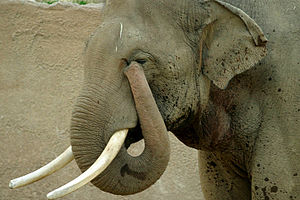Nose: Difference between revisions
imported>Howard Arvi Hughes mNo edit summary |
imported>Thomas E Kelly ([[Category:Health Sciences Workgroup) |
||
| Line 84: | Line 84: | ||
[[Category:CZ Live]] | [[Category:CZ Live]] | ||
[[Category:Biology Workgroup (Top)]] | [[Category:Biology Workgroup (Top)]] | ||
[[Category:Health Sciences Workgroup]] | |||
Revision as of 00:58, 16 February 2007
Template:Disclaim Template:Otheruses
The nose is the portion of the airway preferentially used for inhalation, and contains sense receptors for the sense of smell (olfaction). Newborn human babies breathe "only" through the nose, and are called therefore called "obligate nasal breathers". Crying newborns sometimes are able to breathe in through the mouth, and by several months of age, all normal infants are able to use both the nose and mouth for breathing. Many adults are mouth-breathers. Preferential inhalation through the mouth is generally either a learned habit, or performed because nasal obstruction resists airflow.
In humans, the nose is located centrally on the face; on most other mammals, and in reptiles and amphibians, it is on the upper tip of the snout.
The nose acts an interface between air within the body's respiratory passages and the atmosphere of the external world. The nose and associated structures (the paranasal sinuses) are concerned with conditioning the entering air (for instance, by warming and/or humidifying it) and sometimes with reclaiming moisture from the air before it is exhaled (as occurs most efficiently in camels). The nose also acts as a trap for noxious particles and germs (bacteria and viruses) that enter the body by being inhaled.
In humans, like most mammals, the nose is the primary organ for smelling. As the air is sniffed, it flows in through the nose and over structures called turbinates in the nasal cavity. These turbinates are shaped very much like side-fins. The turbinates slow the air flow and direct it toward the olfactory epithelium. At the surface of the olfactory epithelium, substances carried by the air contact olfactory receptor neurons. When these substances are of a type that the human olfactory system recognizes, the neurons fire and send impulses to the brain. For further information, see sense of smell, olfaction.
In cetaceans, the nose has been reduced to the nostrils, which have migrated to the top of the head, producing a more streamlined body shape and the ability to breathe while the body is almost entirely submerged. Conversely, the elephant's nose has become elaborated into a long, muscular, manipulative organ called the trunk.
Human nose
External Nose
Shapes of the human nose
Nasal Trauma (Broken Nose)
Internal Nose
The nasal airway
The nasal mucosa
The nasal septum
Culture
Some people choose to get rhinoplasty to change the aesthetic appearance of their nose. Nose piercings are also common, such as nostril, septum or bridge.
In New Zealand, nose pressing ("hongi") is a traditional greeting.
People famous for their noses
- Cyrano de Bergerac
- Jimmy Durante
- W.C. Fields
- Major Kovatzov in Nikolai Gogol's novel The Nose.
- Michael Jackson
- Karl Malden
- Jack Nicholson in the film Chinatown (1974) by Roman Polanski
- Barbra Streisand
References
- Physical Manual: Univ. of Tennessee at Martin
- Eden Warwick (pseudonym of George Jabet), Nasology, or hints towards a classification of Noses, London, Richard Bentley, 1848
- Encyclopedia Britannica Micropedia, 1982
See also
- Empty nose syndrome
- hooknose
- sneeze
- photic sneeze reflex
- nose-picking
- nosebleed
- Little's area
- olfactory system
- mucus
- rhinoplasty
- Jala neti
- Sròn
External links
- WebMD: The Sinuses and The Nose
- From the Nose to the Eustachian Tube: Information, videos, tips for diving
- Your Nose: The Guardian Of Your Lungs
- Asian Noses This website discusses the differences in Asian noses.
- The Empty nose syndrome patient association
Template:Respiratory system Template:Human anatomical features
